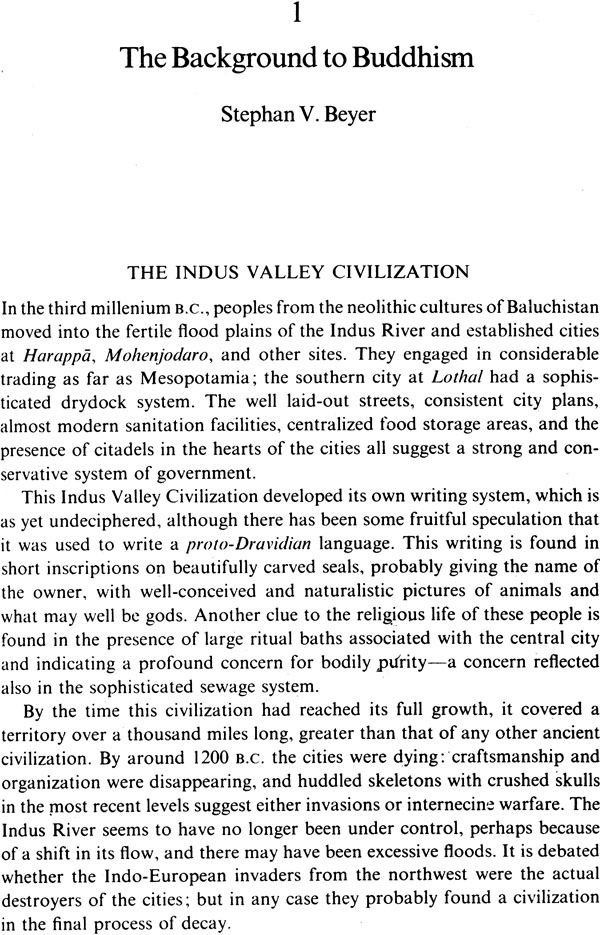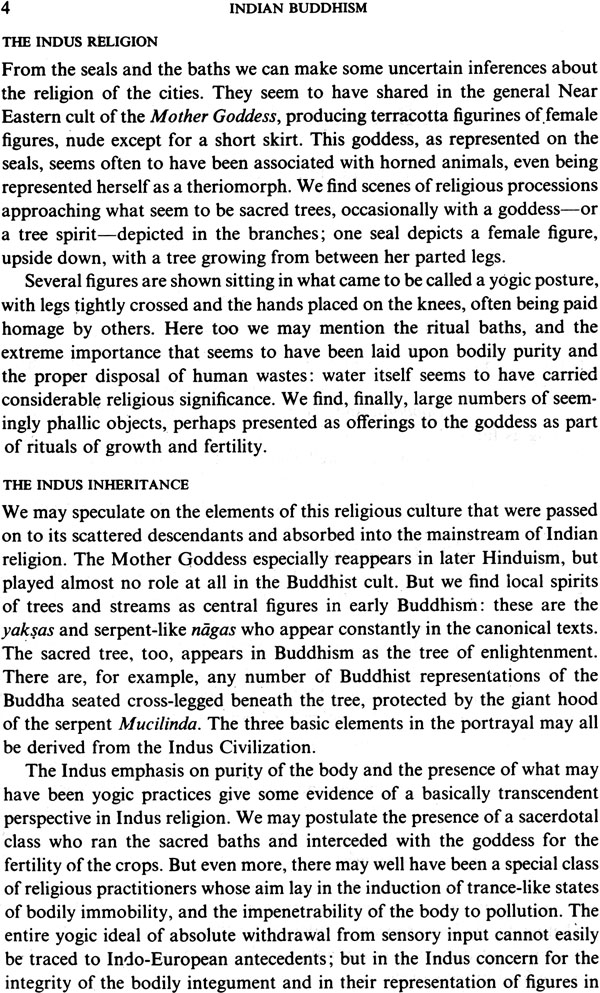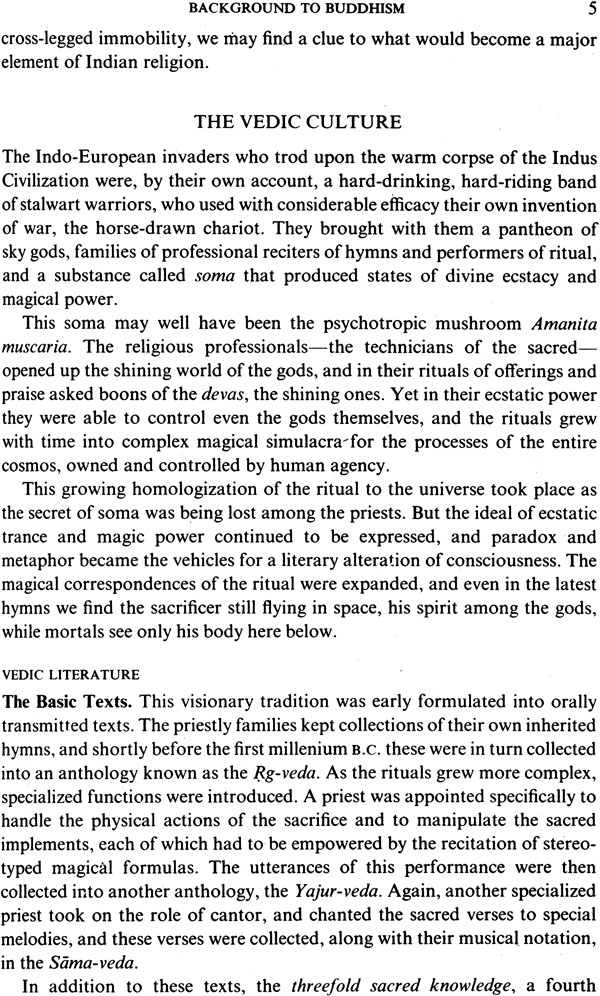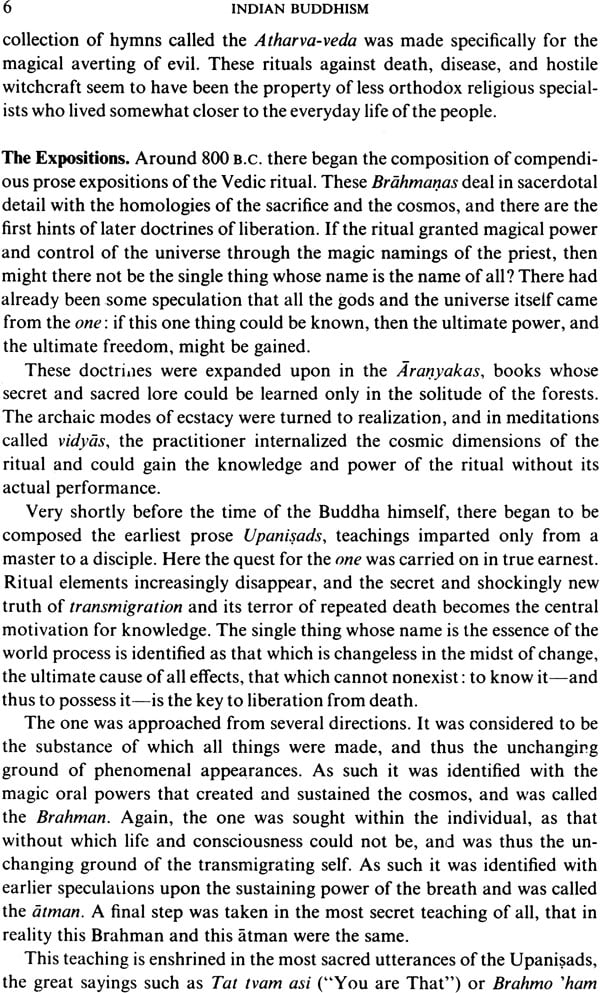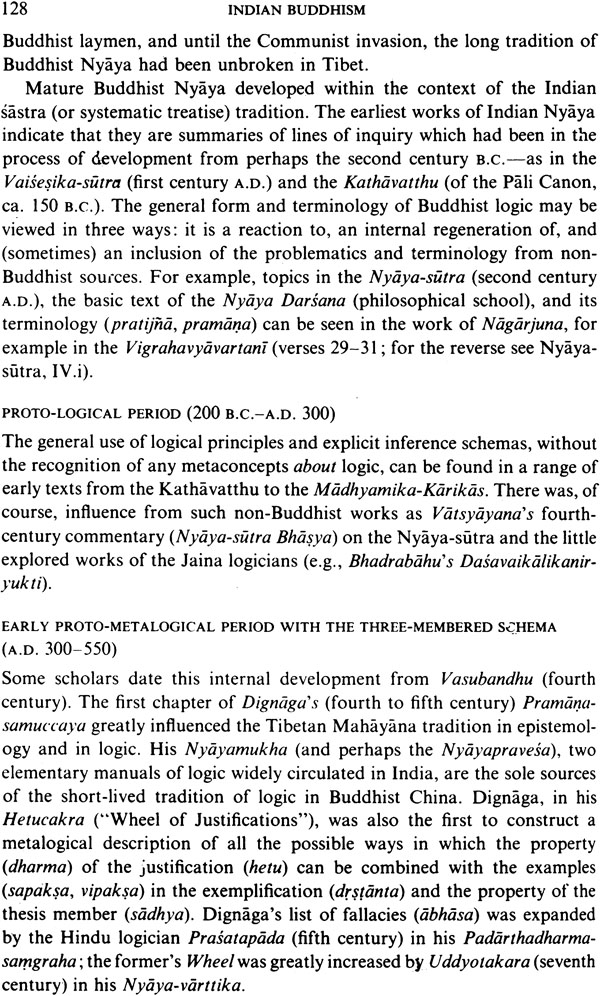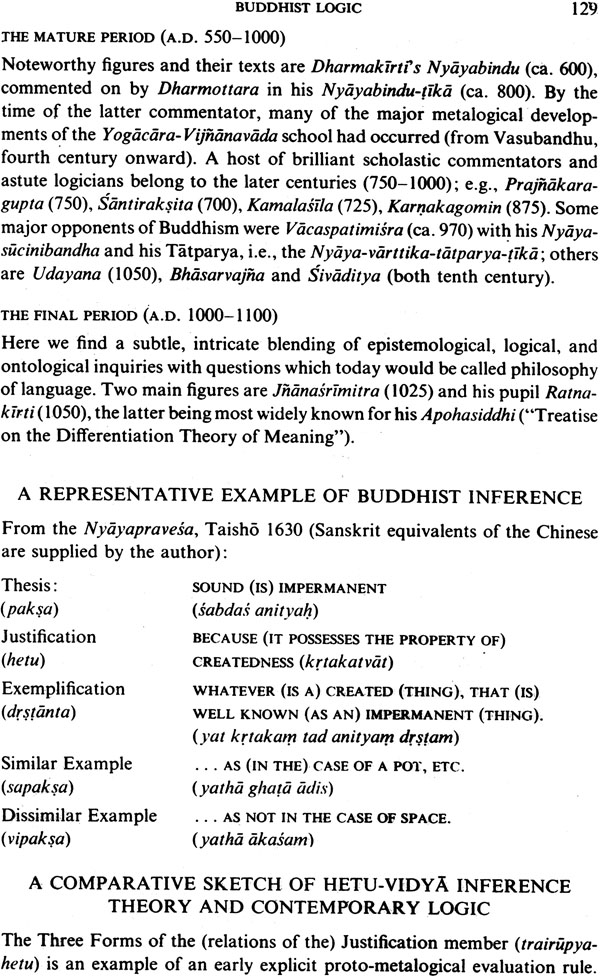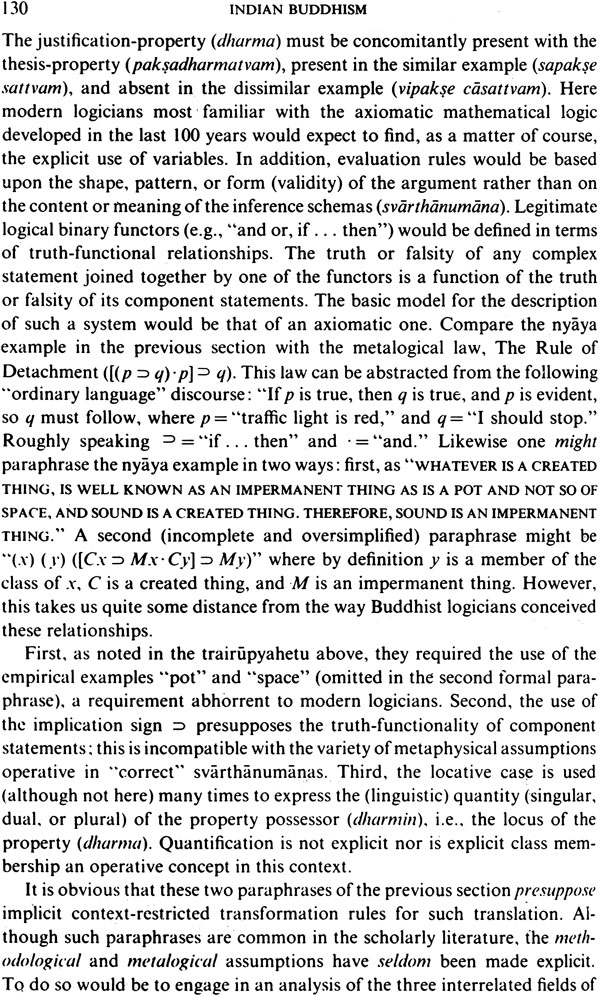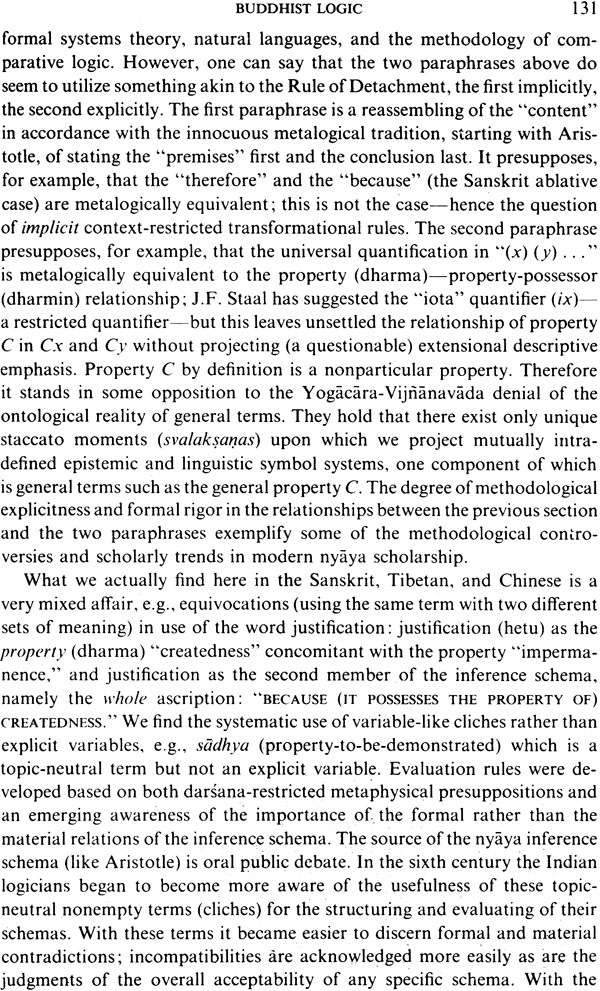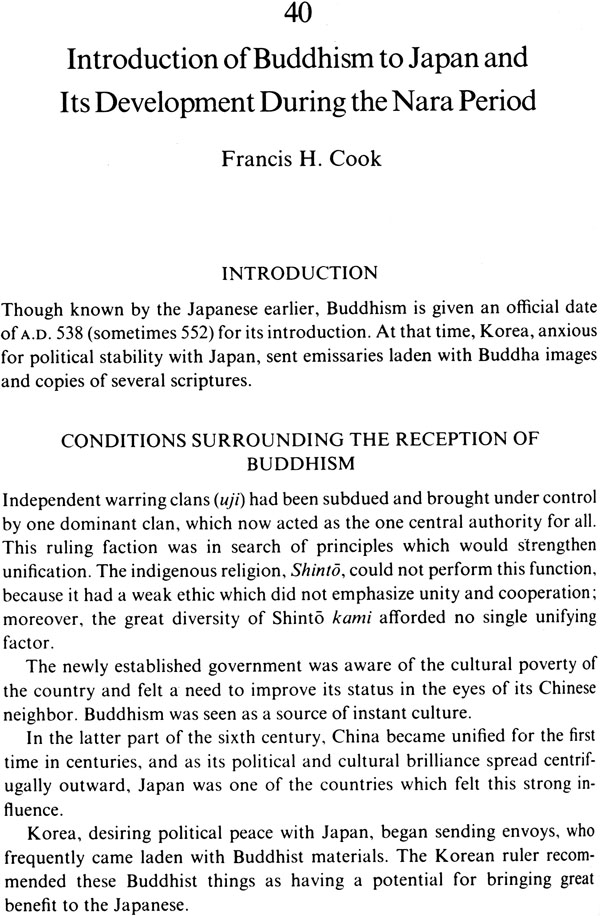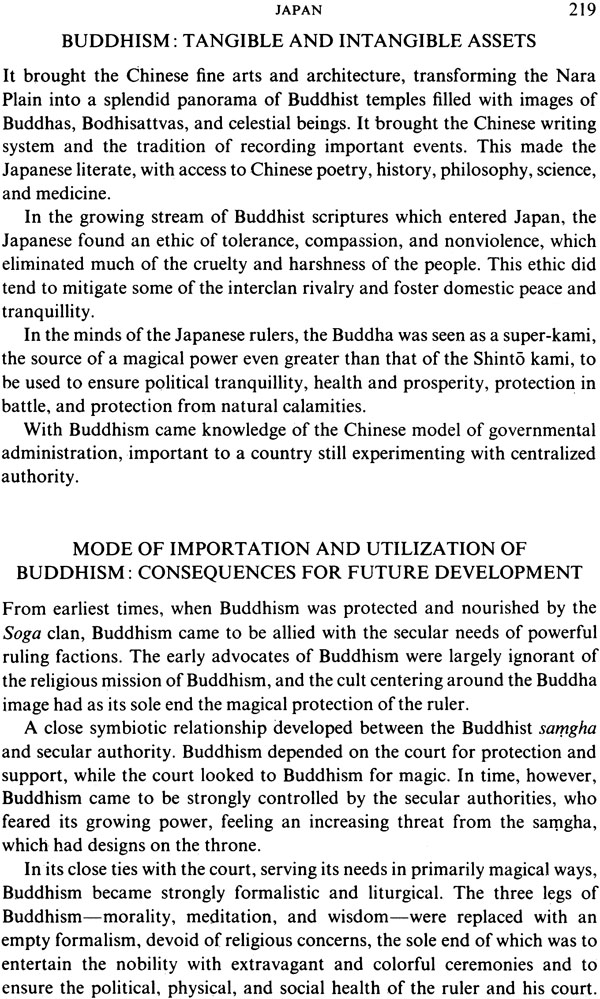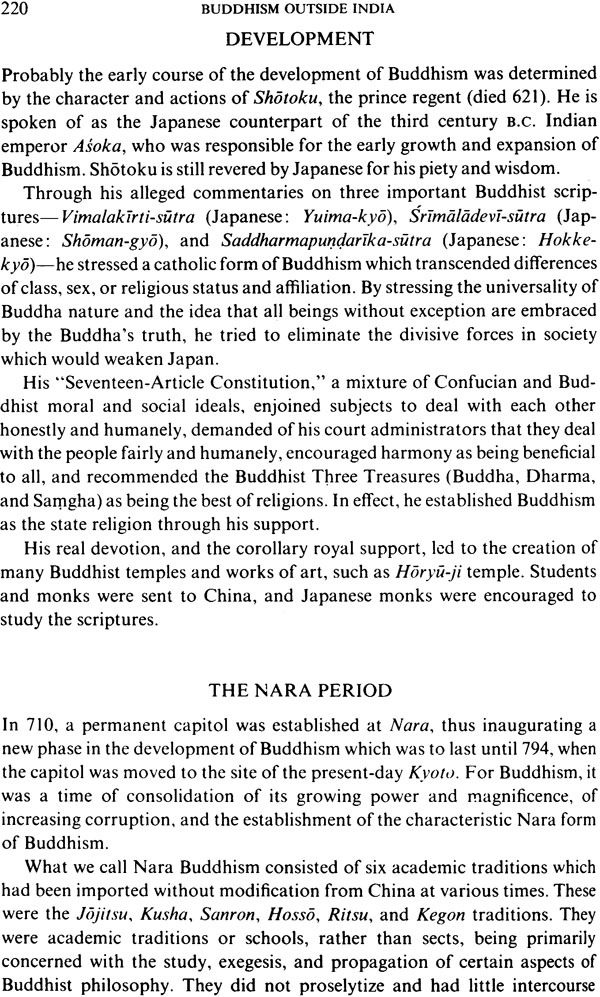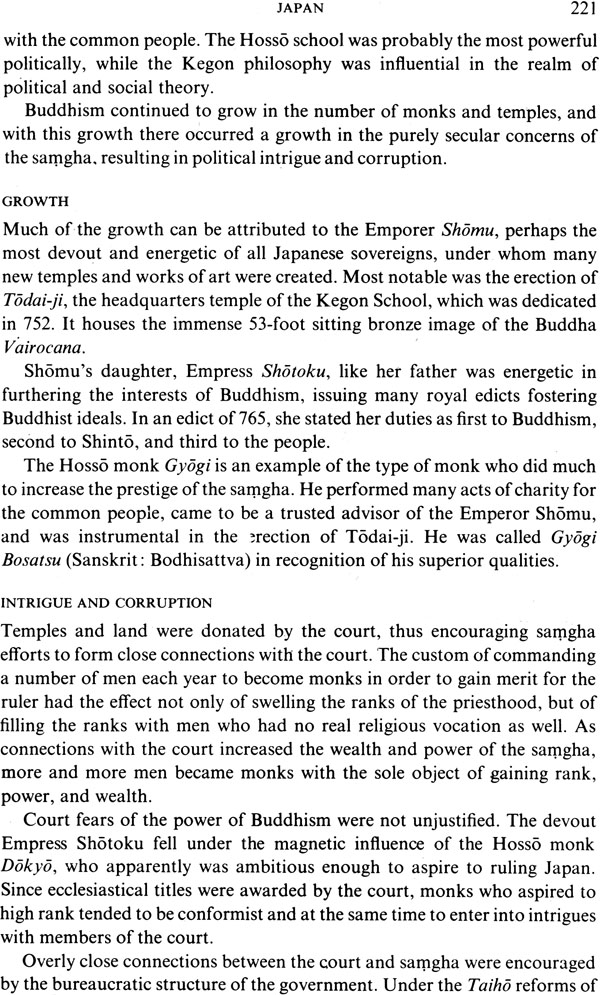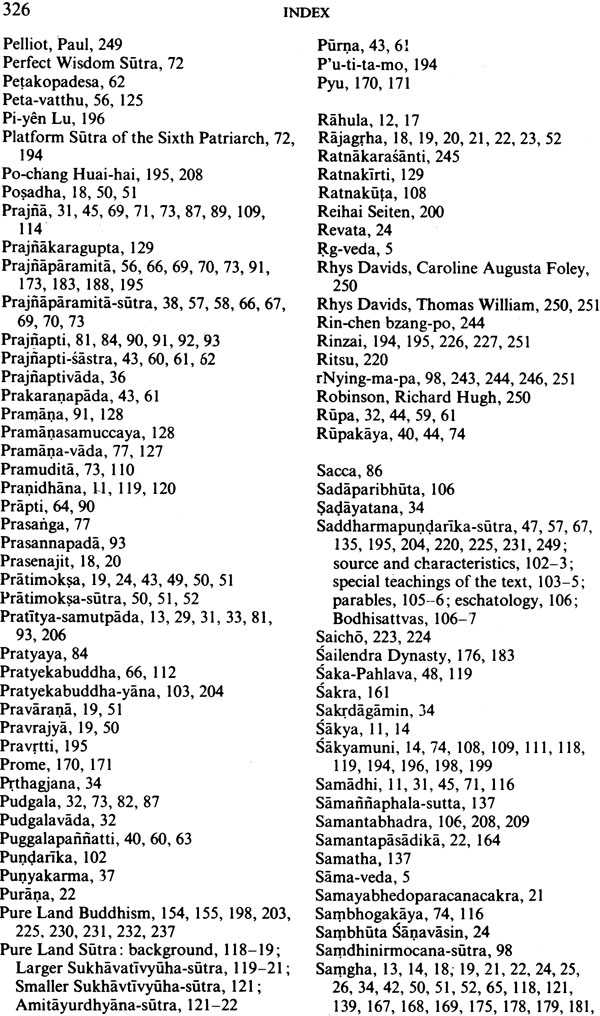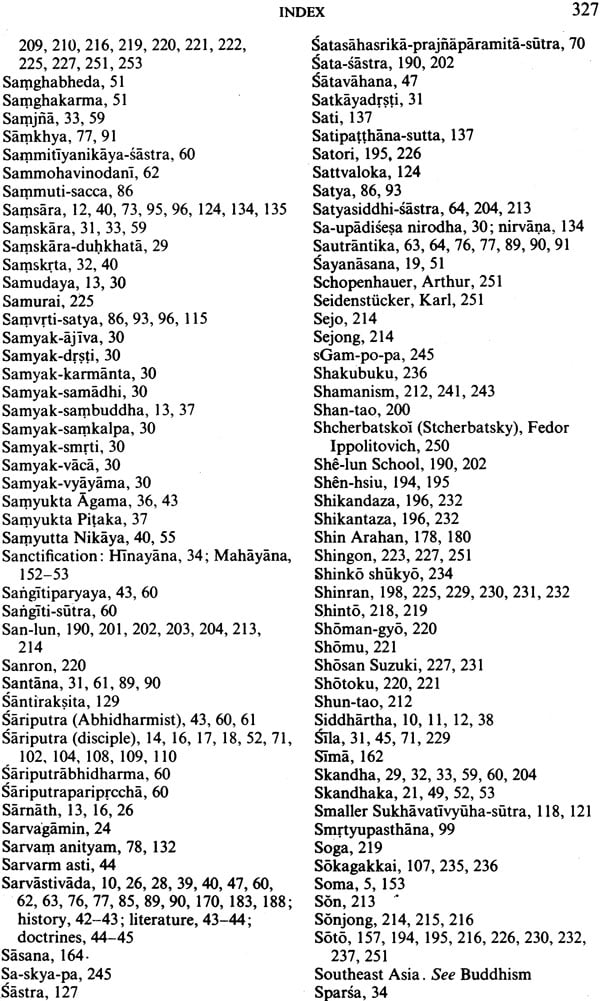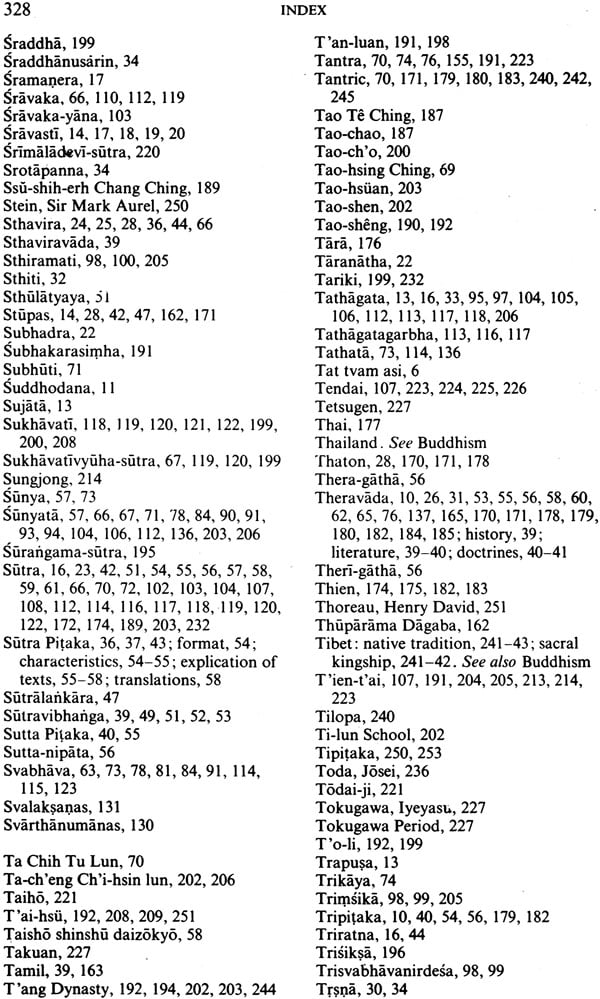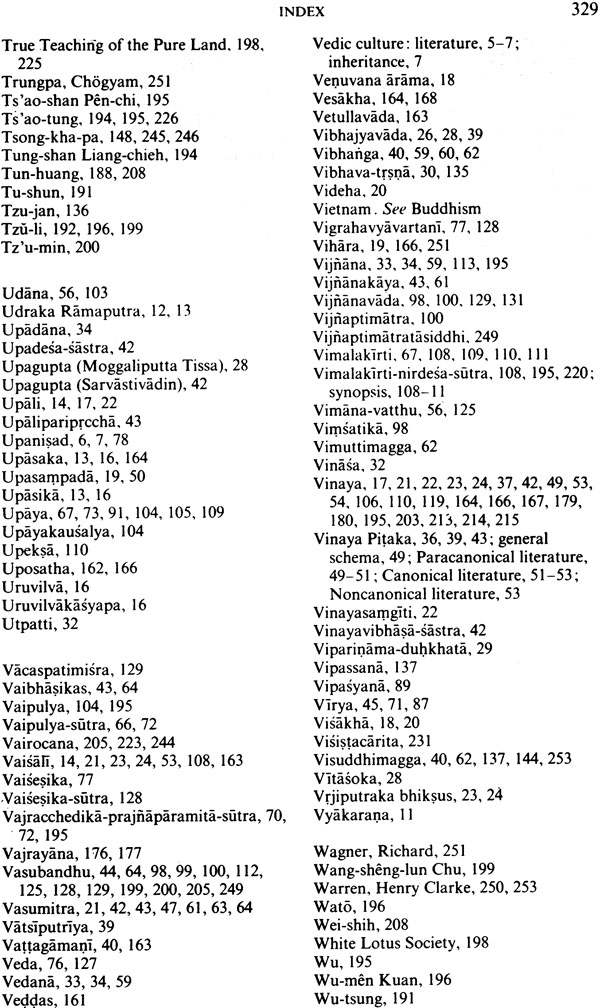
Buddhism: A Modern Perspective
Book Specification
| Item Code: | NAH566 |
| Author: | Charles S. Prebish |
| Publisher: | Sri Satguru Publications |
| Language: | English |
| Edition: | 1975 |
| ISBN: | 8170304199 |
| Pages: | 348 |
| Cover: | Hardcover |
| Other Details | 8.8 inch x 5.8 inch |
| Weight | 510 gm |
Book Description
An introduction to Buddhism of Value both to the scholar and the reader with no prior knowledge of the subject, this book begins with a comprehensive survey of fundamentals and goes on to include topics previously untouched in introductory texts. Buddha's life, basic Buddhist doctrines and practices, the Hinayana and Mahayana sects, Buddhist literature, schools of thought, and meditation are thoroughly discussed. For example, each basket of the Tripitaka or Buddhist canon is discussed individually, and several of the most important Mahayana sutras are considered in detail.
Much of this book is devoted to Indian Buddhism, but discussions of Buddhism in China and Japan are also prominent. In addition, this book considers Ceylon and Tibet as well as Southeast Asia and Korea- areas rarely treated in introductory texts. The unique feature of the articles on Buddhism outside India is the attention focused on Buddhism in the modern world. The discussion of Buddhism in the West includes a useful appendix giving the locations of Buddhist groups in the United States.
The book concludes with an extensive glossary of key words used in the text and a thorough and valuable bibliography.
Charles S. Prebish, a member of the Religious Studies Department at The Pennsylvania State University.
Like virtually all persons teaching courses on Buddhism in a university context, I have become keenly aware, in my transactions with students, both undergraduate and graduate, that their introductory investigations of Buddhism are grossly impaired by the lack of purposeful, informative, and intelligible reading materials. This does not mean to imply that Buddhology, as an academic discipline, lacks introductory texts. Quite the opposite state of affairs exists today. However, most of the introductory texts make an error that is both severe and significant in assuming far too much on the part of the student. With no prior knowledge of or exposure to Buddhism, the student simply cannot integrate the complex issues presented in his readings. The classroom problem is thus compounded for the instructor: not only must he try to explain Buddhism, but he must also provide the primary input not supplied in the students' readings.
On the occasion of the annual meeting of The Association for Asian Studies in New York during the spring of 1972, I discussed this serious problem with many of my Buddhologist colleagues, hoping to find a reasonable alternative approach to the problem. Of those I consulted most intensely, all were sympathetic and many offered concrete ideas. Upon my return to University Park, I immediately set to work integrating the essentials of what I had learned from my colleagues, and a preliminary series of lectures in Buddhism was proposed. It was clear that if the project were to approach accomplishing all that it set out to do, no single individual possessed sufficient knowledge, facility, or stamina to bring it to completion. As I began to search for scholars who might lend to the project the degree of training and specialization necessary to make the work effective, I discovered that I was compiling, perhaps by design, a tentative list of Richard H Robinson's former students, although I had not realized just how pervasive both the methodology and substance of Professor Robinson's scholarship Was I had for some rime wanted to compile ;J rather unusual memorial volume, composed of contributions only from Professor Robinson's former students, and now a rather fitting vehicle seemed to emerge. What better way to reveal the manner in which this brilliant scholar's genius had become manifest than to utilize the writings of his former students to actualize that to which Richard Robinson dedicated his life?
When I had completed what I felt to be a list of scholars with the comprehensive talents necessary for such an undertaking, and had secured their affirmative responses, I submitted a preliminary prospectus of lecture topics to each. Within a relatively short time span, the precise topics were agreed upon and work began.
Of course the primary issue, at the outset, is how the lecture topics were chosen. In this regard, our objectives were manifold. We wanted to present a comprehensive study on the introductory level, but we also felt it advisable to include several topics previously untouched in introductory books. We began with basics, for no introductory text would be complete without the usual background materials: a treatment of Buddha's life, the early history of the Buddhist order, basic doctrines, mention of the Hinayana sects, a section on Asoka, the rise and basic doctrines of Mahayana, brief mention of some Mahayana sects, several references to the Buddhist literary tradition, nirvana, meditation, and a survey of Buddhism in China, Tibet, and Japan, as well as India. As a group, we felt that even these topics could be improved upon if the work was done with care. Consequently, we decided to expand this usual treatment. Traditionally, Buddhist councils are discussed with early Buddhist history. We felt, due to the extreme importance of the councils in terms of their implications for the sectarian movement in early Buddhism, that this topic should be dealt with separately. Likewise, since the Hinayana sects provide the ground from which later forms of Buddhism arose, several of the most important groups should also merit their own section. Here we included lectures on the Mahasamghikas, Theravadins, and Sarvastivadins. Kaniska, so important and so overlooked in Buddhist history, was cited for special reference. No book on Buddhism, and certainly no discussion of early Buddhism, would be complete without ample reference to the Tripitaka or Buddhist canon. Nevertheless, most of the prior works mention the divisions of the canon hardly at all, or only at the end of the volume. We felt it imperative to devote a full lecture to each of individual baskets. Basic Mahayana is allotted three full lectures: its rise, its literature, and its doctrines. However, as Mahayana developed and a vast, new literature emerged in the process, it was essential to emphasize the impact of these new texts by including lectures on several of the most important sutras. As with the Hinayana, Mahayana sects had to be taken into account. The problem here is that the two primary Mahayana schools, Madhyarnika and Yogacara, not only provide great difficulty for the beginning student but also for many scholars. In this regard, most literature on the subject is quite sophisticated, aimed for the knowledgeable few, or quite incorrect and useful to nobody. Further, literature on the subject is rarely in English. In the lectures on each of these schools, we feel that we have provided readings that are both accurate and understandable. The concluding lectures on Indian Buddhism discuss areas rarely dealt with in detail, or at all, in introductory books: cosmology, logic, nirvana, and meditation. This latter topic is extremely important to provide in fullness, for as one of my colleagues noted, 'There is no Buddhism without the experiential methods of meditation."
In coming to terms with Buddhism outside of India, we have weighted our lectures most heavily on China and Japan. Nevertheless, we have taken great pains not to exclude Ceylon, Tibet, Southeast Asia, and Korea from proper treatment. In addition, the latter two areas are hardly ever more than simply mentioned in introductory works. The unique feature of our lectures on Buddhism outside of India is that we try to direct some attention, much needed at that, to Buddhism in the modern world. Previously, one had to resort to quite specialized readings to uncover information on Chinese Buddhism and Communism, religion in modern-day Japan or Korea, and Buddhism in the West. For this final lecture, we have also added an Appendix locating various Buddhist groups in the United States. Since the groups listed are from diverse geographic areas in America, it is quite likely that many of those utilizing this text might have the opportunity to visit Buddhist groups in their area, and of course the study of Buddhism in America is truly the newest aspect of Buddhology to emerge.
Lest any volume be falsely accused, it seems appropriate to devote at least a few words to that which we have omitted. We have clearly made a studied omission of lectures on specific Hinayana texts. Perhaps ideally we might have included lectures on the Visuddhimagga, Milindapanha, and Abhidharmakosa. The Visuddhimagga has been omitted as a separate entry primarily because it forms the substance of the lecture on Hinayana meditation. Both Stephan V. Beyer (the author of that lecture) and I feel that its most important aspects are fully dealt with under that heading. While the Milindapanha is not specifically dealt with, the implications of its many pronouncements, as well as its doctrinal affinities, are implicit in many lectures in the text. The Abhidharmakosa too is dealt with both in the lectures on Sarvastivada and the Abhidharma Pitaka. Certainly, on the textual question, we had considered making references in our Suggested Readings to anthologies containing scriptural collections. We opted for omission on this point primarily because we wanted to provide the greatest flexibility for our readers. Rather than choosing one of the many fine anthologies (e.g., those of de Bary, Conze, or Beyer), we felt it most appropriate to leave that choice open to those utilizing the volume. We do, however, make reference to many translations of specific texts, thus reflecting our own textual concern as well as providing a guide for ambitious students. We would like to have included a section on popular Buddhism. The experience of the contributors has been that these studies are most often entertained by anthropologists with imperfect training in Buddhology or Buddhologists with imperfect training in anthropology. In either case, the results are usually disastrous. Indeed, with very few exceptions, literature on popular Buddhism has not lived up to the highest standards. A lecture on Buddhist art also would have been valuable. Certainly, other topics not mentioned here could have been included, but limits and restrictions (particularly length) had to be considered.
The format for the lectures has been dictated solely on the basis of pragmatic concerns. This is a book designed to provide basic input for beginners, and we wanted to adopt a format that would promote rather than frustrate study of this difficult topic. Consequently, the basic outline format provides the most simple, direct, and organized fashion for structuring one's study. In addition, key words (whether they be technical terms in the various Buddhist languages or critical signposts in English) have been italicized on their first appearance in each lecture and elsewhere in the lecture where they are critical to understanding a given topic. In addition, Suggested Readings are provided at the conclusion of each lecture. These readings should not be construed to be a complete bibliography on the lecture but rather a sampling of that literature which the author of the lecture feels would enhance the understanding of the reader. The entries from the Suggested Readings section of each lecture have been gathered together and presented in a complete bibliography at the conclusion of the text. We feel that this bibliography represents the most ambitious and complete collection of books ever presented in an introductory text. Since the text is filled with many Buddhist technical terms, place names, names of famous texts and persons, etc., we have compiled a glossary containing brief definitions or identifications for the most important of these. To include them all would prove neither practical nor useful. Nevertheless, since one's introductory study of Buddhism is often confounded oy repeated exposure to this sometimes overwhelming new vocabulary, we hope that our glossary, again the most complete such enterprise in an introductory volume, will lessen the pains and bewilderment so often apparent in beginners.
To prepare a complete list of acknowledgments for this volume would obviously be impossible. However, several persons cannot be overlooked. Joseph Elder. whose Lectures in Indian Civilization provided the take-off point for this volume, both in format and effectiveness, must be singled out for thanks by each contributor. Luther H. Harshbarger, who was instrumental in aiding me obtain a grant which helped defray some of the costs involved in bringing the project to completion, and who is uncanny in constantly providing profitable suggestions, must receive the special thanks of the editor. In this regard, I am particularly grateful to The Pennsylvania State University for providing those monies mentioned above. To our students, who were often unaware that they were our trial audience, and who in a very real sense shaped the entire volume by their inquiries, problems, and frustrations, we offer our gratitude. Like all education, the study of Buddhism is indeed the proverbial "two-way street," and without our students to teach us, there would be no Buddhism: A Modern Perspective. Finally, the greatest thanks must go to Professor Richard H. Robinson. Although his life and career were cut short at the height of productivity, we all sincerely hope that this volume will be but one manifestation of the myriad ways in which Richard has influenced Buddhology. Hardly a sincere student of Buddhism emerges who has not been influenced by Richard Robinson in a very profound way. Often we hear of "schools" of Buddhist scholarship growing up around a great professor: the students of Thomas W. Rhys Davids, the students of Th. Stcherbatsky, or the students of Louis de La Vallee Poussin. What all these great scholars and schools shared was a common question, however variously it may have been asked. And one can be sure of hearing of the students of Richard H. Robinson, including those who have not contributed here. Nevertheless, something significant seems to have changed, for Richard H, Robinson, in his own fashion, rewrote the rulebook. Richard found new questions to ask, and with the asking has changed the face of Buddhology. If he could see the new face, there are no doubts it would be grinning.
| List of Contributors | 11 | |
| Foreword | IX | |
| Preface and Acknowledgments | xi | |
| Part I: | INDIAN BUDDHISM | |
| 1 | The Background to Buddhism | 3 |
| (Stephan V. Beyer) | ||
| 2 | Life of the Buddha | 10 |
| (Charles S. Prebish ) | ||
| 3 | Early History of the Buddhist Order | 16 |
| (Charles S. Prebish ) | ||
| 4 | Buddhist Councils and Divisions in the Order | 21 |
| (Charles S. Prebish) | ||
| 5 | Asoka and the Missionary Activity of the Buddhists | 27 |
| (Stefan Anacker ) | ||
| 6 | Doctrines of the Early Buddhists | 29 |
| (Charles S. Prebish ) | ||
| 7 | Major Schools of the Early Buddhists: Mahasamghika | 36 |
| (Charles S. Prebish ) | ||
| 8 | Major Schools of the Early Buddhists: Theravada | 39 |
| (Charles S. Prebish ) | ||
| 9 | Major Schools of the Early Buddhists: Sarvastivada | 42 |
| (Charles S. Prebish ) | ||
| 10 | Kaniska | 46 |
| (Stefan Anacker ) | ||
| 11 | The Vinaya Pitaka | 49 |
| (Charles S. Prebish ) | ||
| 12 | The Sutra Pitaka | 54 |
| (Francis H. Cook ) | ||
| 13 | The Abhidharma Pitaka | 59 |
| (Stefan Anacker ) | ||
| 14 | The Rise of the Mahayana | 65 |
| (Lewis R. Lancaster ) | ||
| 15 | The Prajnaparamita Literature | 69 |
| (Lewis R. Lancaster ) | ||
| 16 | Doctrines of the Mahayana | 72 |
| (Lewis R. Lancaster ) | ||
| 17 | Major Schools of the Mahayana: Madhyamika | 76 |
| (Doug/as D. Daye) | ||
| 18 | Major Schools of the Mahayana: Yogacara | 97 |
| (Stefan Anacker ) | ||
| 19 | The Saddharmapundarika-Sutra | 102 |
| (Mark A. Ehman ) | ||
| 20 | The Vimalakirti-Nirdesa Sutra | 108 |
| (Stefan Anacker) | ||
| 21 | The Lankavatara Sutra | 112 |
| (Mark A. Ehman ) | ||
| 22 | The Pure Land Sutras | 118 |
| (Mark A. Ehman ) | ||
| 23 | Cosmology | 123 |
| (Doug/as D. Daye ) | ||
| 24 | Buddhist Logic | 127 |
| (Douglas D. Daye ) | ||
| 25 | Nirvana | 133 |
| (Francis H. Cook ) | ||
| 26 | The Doctrine of Meditation in the Hinayana | 137 |
| (Stephan V. Beyer ) | ||
| 27 | The Doctrine of Meditation in the Mahayana | 148 |
| (Stephan V. Beyer ) | ||
| Part II: | BUDDHISM OUTSIDE INDIA | |
| 28 | Early History of Buddhism in Ceylon | 161 |
| (Mark A. Ehman ) | ||
| 29 | Monastic Life in Ceylon | 166 |
| (Charles S. Prebish ) | ||
| 30 | Introduction of Buddhism to Southeast Asia and Subsequent History up to the Eleventh Century | 170 |
| (Stefan Anacker) | ||
| 31 | Medieval Buddhism in Southeast Asia | 178 |
| (Stefan Anacker) | ||
| 32 | The Spread of Buddhism into China | 187 |
| (Roger J. Corless) | ||
| 33 | History of Buddhism in China | 190 |
| (Roger J. Corless) | ||
| 34 | Ch'an | 194 |
| (Roger J. Corless) | ||
| 35 | Ching-t'u | 198 |
| (Roger J. Corless) | ||
| 36 | Chinese Academic Schools and Doctrinal Innovations | 201 |
| (Francis H. Cook) | ||
| 37 | Chinese Buddhism and the Communist Regime | 208 |
| (Roger J. Corless) | ||
| 38 | Introduction of Buddhism to Korea and Subsequent Development | 212 |
| (Lewis R. Lancaster) | ||
| 39 | Buddhism in Korea Survives Suppression and Change | 215 |
| (Lewis R. Lancaster) | ||
| 40 | Introduction of Buddhism to Japan and Its Development During the Nara Period | 218 |
| (Francis H. Cook) | ||
| 41 | Heian, Kamakura, and Tokugawa Periods in Japan | 223 |
| (Francis H. Cook) | ||
| 42 | Japanese Innovations to Buddhism | 229 |
| (Francis H. Cook) | ||
| 43 | Japanese Buddhism and the New Religions | 234 |
| (Francis H. Cook) | ||
| 44 | Buddhism in Tibet | 239 |
| (Stephan V. Beyer) | ||
| 45 | Buddhism and the West | 248 |
| (Roger J. Corless) | ||
| Appendix: | Partial Listing of Representative Buddhist Groups in the United States | 255 |
| (Roger J. Corless and Charles S. Prebish) | ||
| Glossary | 259 | |
| Bibliography | 311 | |
| Index | 319 |
